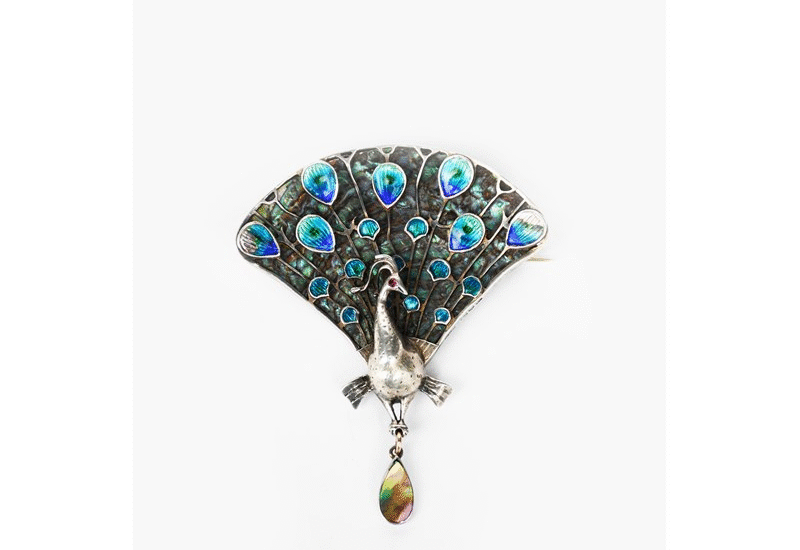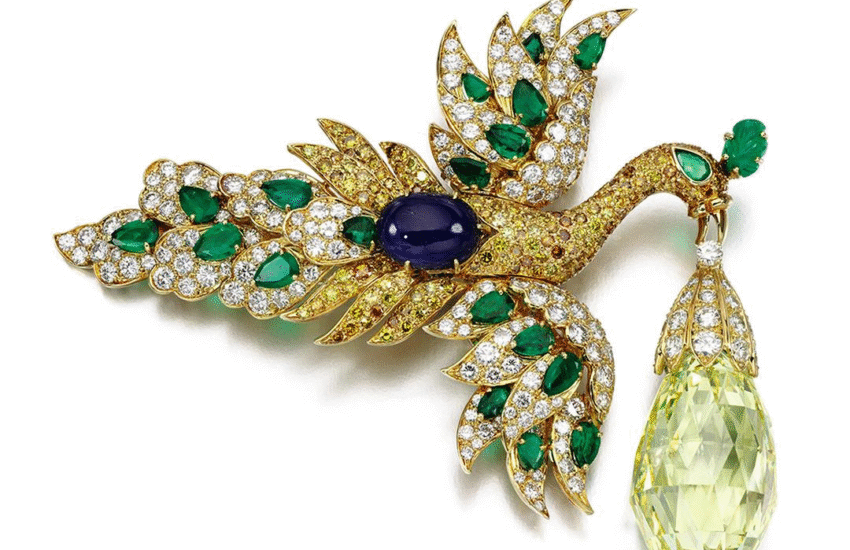Five great museums to see jewellery
The best and certainly most fun way to learn about jewellery is to go and see it. These five great museums have fabulous collections and are the perfect place to go and see jewellery close up, from the most ancient pieces to cutting edge contemporary jewels.
William and Judith Bollinger Jewellery Gallery, Victoria and Albert Museum, London
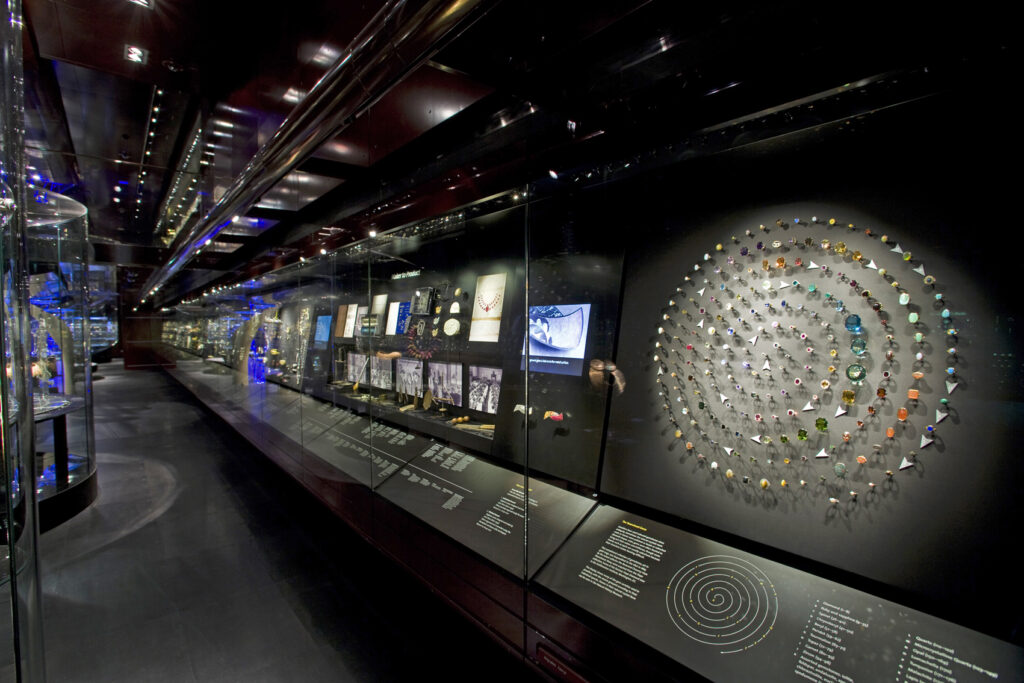
The V&A’s jewellery gallery has to be first on the list for jewellery fans. I spent many happy years working here and it’s one of the best places in the world to see jewellery on permanent display.
The gallery shows jewellery from a huge gold Bronze Age gorget up to the creations of the most renowned contemporary makers. 150 years of collecting results in what Dame Joan Evans, one of the most generous donors in the museum’s history, described as ‘the best conspectus of jewels I have ever seen’.
The gallery showcases over 3000 jewels made in the Western tradition. They are organised chronologically, and include fabulous gold snuff boxes and early watches. The interior is dark, reminiscent of a jewellery box. Looking down the gallery, the walls are lined with display cases filled with boards of jewels. The central spine of the gallery features dramatic curving glass cases which hold some of the most iconic objects in the collection.
Although most of the historic jewels are made of metals and gemstones, the twentieth century section sees an explosion of new possibilities. Contemporary jewels made of paper, hair, bone, plastics, clay pipes found on the Thames foreshore, broken glass and wire show that anything goes in the service of creativity. Curators are active in growing the collection and put out new objects regularly.
Heading up the central glass staircase, you will find not only watches and boxes but also a wall of traditional European jewellery (formerly rudely described as ‘peasant’). British foreign minister Viscount Castlereagh ordered an extraordinary gold inkstand to be made to celebrate the signing of the Treaty of Vienna, the end of the Napoleonic Wars of the early nineteenth century. Weighing an impressive 148 troy ounces, it is surrounded by gold boxes set with portrait miniatures. Art Deco glamour comes to life with a collection of vanity cases lent by the sister of singer Freddie Mercury. Drawers hold jewels set with hair or textiles which are too fragile to bear the light.
It’s worth bearing in mind that not every jewel in the V&A is in the jewellery gallery. Some wonderful objects can be found in the Indian and South East Asian galleries, the British Galleries and Europe 1600-1800 as well as a sprinkling in the Ceramics galleries on the top floor.
What to read
Jewels and Jewellery Clare Phillips, Thames and Hudon/ V&A , 2019
Rings Rachel Church, Thames and Hudon/ V&A, 2017
Brooches and Badges Rachel Church, Thames and Hudon/ V&A, 2019
Indian Jewellery, Nick Barnard, Timeless Books, 2008
A Golden Treasury: Jewellery from the Indian Subcontinent, Sue Stronge, V&A, 1989
British Museum, London
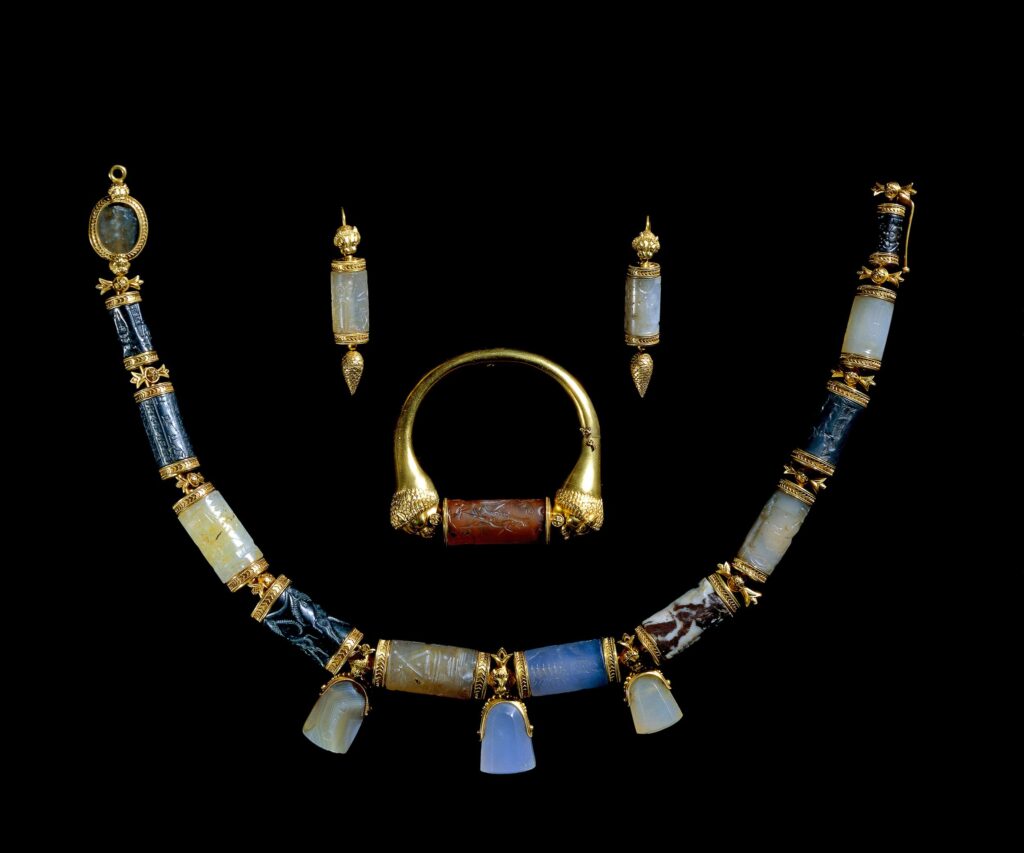
Rather than having a dedicated space, the British Museum spreads its wonderful jewellery collection across its site. The museum has fabulous collections of antiquities, including jewellery found in excavations across the ancient world and taken from Egyptian tombs and pyramids.
The collection is rich in medieval objects, including a large group of pilgrim badges. Nineteenth century collector, Sir Augustus Woolaston Franks spent 45 years working at the museum, building a collection of British antiquities. He also put together an exceptional personal collection of rings, which he left to the museum on his death.
Voracious collector Anne Hull-Grundy hugely enriched the later collections. She was a remarkable accumulator of jewels – including nineteenth century jewellery, which was completely out of fashion and under-valued. Eventually, she gave over 900 jewels to the British Museum.
What to read:
Jewellery in the Age of Queen Victoria: a mirror to the world. Charlotte Gere and Judy Rudoe, British Museum Publications, 2010
The Art of the Jeweller: A Catalogue of the Hull Grundy Gift to the British Museum : Jewellery, Engraved Gems, and Goldsmiths’ Work. Charlotte, Gere, British Museum Publications, 1984.
Galerie des Bijoux, Musée des Arts Décoratifs, Paris
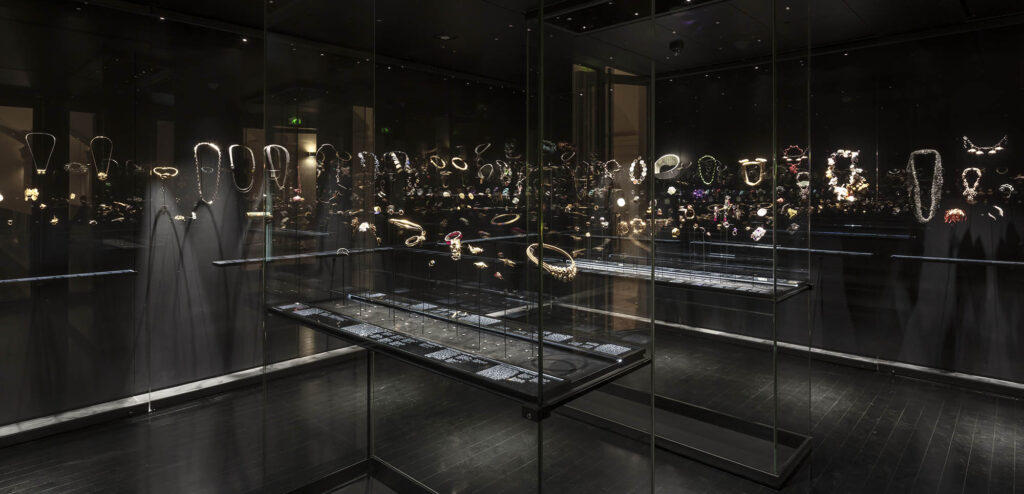
Paris is one of the centres of the fine jewellery world and it boasts its own permanent jewellery display. The Galerie des Bijoux can be found in the Musée des Arts Décoratifs, a stone’s throw from the Louvre. It opened in 2004, showcasing some of the 4000 jewels from the museum’s collection.
Looking down the galleries, visitors can see jewels from the Merovingian period to the twenty-first century. The collection is particularly rich in eighteenth and nineteenth century jewels – the earlier jewels a rare survival after the disruptions of the French Revolution. French jewellers like Line Vautrin are well represented. Exceptional pieces of Art Nouveau jewellery are amongst the highlights of the displays. Henri Vever, the great early twentieth century jewellery and historian enriched the collection with his gift of over 300 pieces in 1924. Some of the loveliest pieces made by René Lalique, Lucien Gaillard and Georges Fouquet came as part of this donation.
The displays are laid out in two rooms separated by a hallway and stairwell, the first room covers historic jewellery. Wall cases hold displays on materials and jewellery techniques. Jewels from China, India and Japan are displayed in cases in the centre of the gallery.
Across the hall, jewels from the 1940s onwards are arranged, either chronologically or in cases dedicated to a particular maker. The collection continues to grow through donations and purchases.
What to read:
Flora: the Art of Jewellery, Patrick Mauriès et Évelyne Possémé, Thames and Hudson, 2016
Figures and Faces: the Art of Jewellery, Patrick Mauriès et Évelyne Possémé, Thames and Hudson, 2018
Schmuckmuseum Pforzheim, Germany

How about a whole museum just for jewellery? As the name suggests, the Schmuckmuseum is an institution entirely devoted to it. Based in the jewellery centre of Pforzheim, it’s in the striking modernist Reuchlinhaus, built in 1961 as a cultural centre for the city. It’s set in a park and has a very nice café to refresh you after your visit.
Pforzheim’s engagement with jewellery began in 1767 when a watchmaking firm was founded in the city, shortly followed by a jewellery firm. Conveniently based in the city’s orphanage, the earliest workers were orphans, trained up in the craft and put to work. By the nineteenth century, Pforzheim was the centre of German jewellery manufacturing, exporting its wares across the world. The museum’s displays include a section on this history.
The watch industry, a key part of Pforzheim’s history, is also well represented. Gorgeous eighteenth century watches and chatelaines, early Swiss watches (including an intriguing watch shaped like a cockroach, which opens its wings to reveal the watch face) are joined by watches set in rings, bracelets and pendants. The collection put together by Philipp Weber is on long term loan and includes watches from the sixteenth to the twentieth centuries.
The jewellery collections range over 5000 years, from the third millennium BC to the present day. Germany was one of the original sources for the new jewellery movement which began in the 1950s as an interrogation of the place of jewellery in the world. The Schmuckmuseum acquired its first pieces of artist jewellery in 1961 and continues to actively support contemporary makers. The displays show objects from over twenty countries and form one of the most comprehensive collections of studio jewellery in the world.
A gallery of world jewellery, collected by Eva and Peter Herion, collected over thirty years, brings together jewels from Africa, Asia, Oceania and the Middle East.
The museum holds regular exhibitions, generally accompanied by excellent catalogues.
What to read:
Schmuckmuseum Pforzheim: Museum Guide, Cornelie Holzach, 2015
The Metropolitan Museum of Art, New York

You’ll have to stretch your legs to enjoy the jewellery in the Met. The museum holds a wonderful collection of jewellery but it’s distributed across the decorative art and historic galleries.
The 2018 exhibition The Body Transformed and its accompanying catalogue showed just how rich the museum’s collections are. Objects ranged from Bronze Age pins, ancient Egyptian jewels, astonishing goldwork from the Pre-Columbian empires of South and Central America into the middle ages, and onwards.
The museum also collects interesting work by contemporary artist and studio jewellers, enriched by a large donation from Donna Schneier.
What to read:
Unique by Design: Contemporary Jewelry in the Donna Schneier Collection, Suzanne Ramljak, Metropolitan Museum of Art Publications, 2014
Jewelry: the Body Transformed, Pillsbury, J., Benzel, K., Craig Patch, D., Lee, S., Wees, B. C., Metropolitan Museum of Art Publications, 2018
Metropolitan Jewelry, Sophie McConnell, Metropolitan Museum of Art Publications, 1991. It’s out of print, but can be read for free online or downloaded as a pdf via the museum website. https://www.metmuseum.org/art/metpublications/Metropolitan_Jewelry
Finally
There are a lot of ways to learn about jewellery, including an increasing number of talks and courses – here is a round-up of some of the best.
I’ve also put together a reading list for rings and for brooches.

